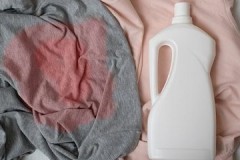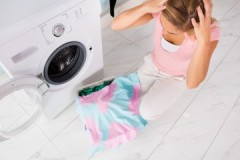Effective recipes and ways to remove blood from clothes at home
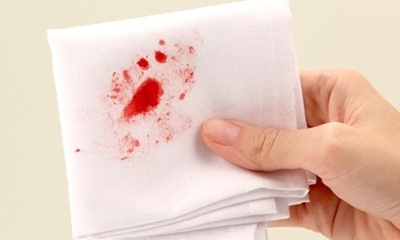 Blood stains are among the most difficult to remove. Household chemicals and homemade recipes will help to cope with the task.
Blood stains are among the most difficult to remove. Household chemicals and homemade recipes will help to cope with the task.
In addition, one should take into account the peculiarities of processing such marks and the presence of a number of prohibitions.
For more information on how to wash blood (fresh, dried, old) from clothes at home, in what water to process the fabric, read the article.
Content
Fresh spots
The washing performance is highly dependent on how long after the stain appears and on the type of fabric. The faster you start removing traces of blood, the better the result will be.
A simple way to remove stains:
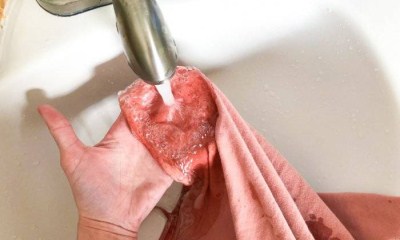 Hold the affected area under running cold water.
Hold the affected area under running cold water.- Fill a basin with cold water.
- Dilute the detergent.
- Rub the damaged area of the material with laundry soap.
- Soak the item for 30-40 minutes.
- Extend.
- Rinse.
The complexity of blood stains is in the protein contained and in the hemoglobin. Protein has the property of curdling from temperature exposure, and iron from blood hemoglobin gives the spot a reddish tint, which is difficult to remove.
Old, withered
Traces of blood that have already dried up will be much more difficult to remove. If the recipe you use doesn't work, you can use another one.
It is advisable to start processing by soaking the whole thing in cold water... This technique will prepare the fabric for further processing.
If, after soaping with Antipyatin or laundry soap, the stain has not completely gone away, proceed to removing the marks using one of the recipes.
Dishwashing gel
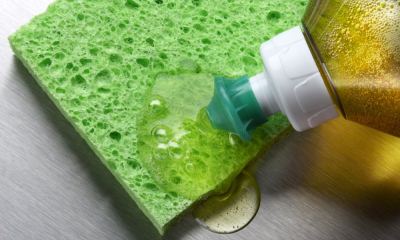 Shampoo or dish soap can be used to remove stains if nothing else is on hand and the stain is still old.
Shampoo or dish soap can be used to remove stains if nothing else is on hand and the stain is still old.
For this moisten the material, apply the selected preparation and rub gently... After 10 minutes, wash and rinse the item.
Another way is to apply undiluted dishwashing gel directly to the stained area of the material. Apply generously, not in a thin layer.
After that, cling film is placed on top and left in this form for a couple of hours or even more, up to five. After that, the product is washed.
Hydrogen peroxide
White things can be treated with hydrogen peroxide, but only if the material is natural (cotton, linen) and dense.
The procedure for removing stains:
- Pour the peroxide bottle over the stain. Or process it using a sponge.
- Withstand the time while the chemical reaction is taking place.
- Wash the thing.
This method is only suitable for thick enough fabrics, and is not recommended for delicate fabrics.
Salt
To remove the stain it is necessary to prepare a solution:
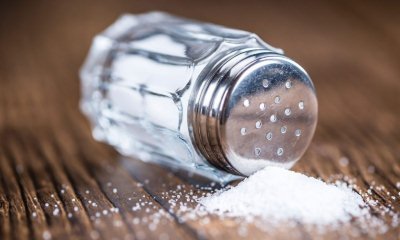 pour 3 liters of cold water into a basin;
pour 3 liters of cold water into a basin;- add 60 grams of salt;
- stir;
- dip soiled clothing;
- leave for 6-8 hours;
- wash with Antipyatin or with laundry soap;
- rinse.
For delicate fabrics, the salt version is undesirable.
Soda
Removing stains with soda is carried out according to the following method:
- Pour 1 glass of cold water into a container.
- Pour 10-15 grams of soda into it.
- Stir.
- Pour the solution over the mark.
- Leave for 30 minutes.
- Rub the dirty place.
- Wash the item using a detergent.
The recipe is for thick fabrics.
Ammonia
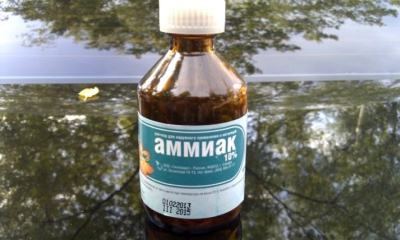 Ammonia allows you to remove blood from clothes, sheets and other soiled items made of linen or cotton.
Ammonia allows you to remove blood from clothes, sheets and other soiled items made of linen or cotton.
Procedure:
- pour 3 liters of water into a basin;
- pour in 60 ml. ammonia;
- soak a thing;
- hold in solution for a couple of hours.
Potato starch
Almost any recipe can be used for heavy cotton and linen fabrics, but for delicate things, you need to act differently:
- Pour ½ cup of starch into a container.
- Add a little water to form a gruel.
- Apply the mixture to the fabric.
- Set aside the item for the time necessary for the gruel to dry completely.
- Clean off the remnants of gruel from the material with a dry cloth or towel.
- Wash the product.
Vinegar
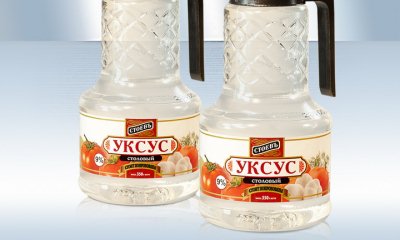 Table vinegar, thanks to its acidity, can be a good stain remover. A local spot can be treated with undiluted liquid and left for half an hour.
Table vinegar, thanks to its acidity, can be a good stain remover. A local spot can be treated with undiluted liquid and left for half an hour.
If there are several spots in different places, then it would be better to prepare a solution of two parts water and one part vinegar... The thing is completely dipped into it and left for 10-15 minutes, after which it is washed.
In order for the vinegar to work 100%, and completely remove the stains, it should be used within the first days after the formation of the mark. After this period, acetic acid will be less effective.
Glycerol
Glycerin is often used for cleaning stains. For the best effect of manipulation, the glycerin bottle should be warmed up a little so that it becomes warm.
Lemon and salt
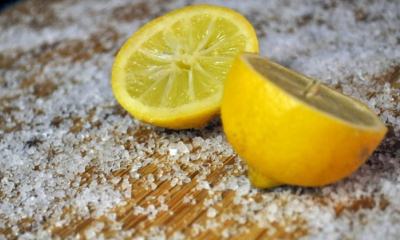 Lemon juice is a natural product that comes to the rescue in removing a variety of stains. Citric acid, like acetic acid, can also deal with blood stains.
Lemon juice is a natural product that comes to the rescue in removing a variety of stains. Citric acid, like acetic acid, can also deal with blood stains.
For cleaning, prepare the following mixture:
- in a container, mix 2 tbsp. l. lemon juice and 1 tbsp. l. salt;
- using an old toothbrush, they process the fabric;
- rinse the material with cold water.
The disadvantage of this method is the relatively low efficiency in relation to extensive or old spots. And the impossibility to use on colored fabrics.
Top 3 household chemicals
In addition to home recipes, household chemicals can be used. These include modern stain removers in various forms of release (from liquids to powders and sticks).
The principle of the stain remover is a chemical reaction in which foam can even form... As long as this effect persists, the cleanser should not be rinsed off.
Special stain remover Dr. Beckmann
This product of the well-known TM is designed to remove not only blood stains, but also other contaminants of protein origin.
Using the stain remover is very simple:
- Apply the product to the blood.
- Leave on for 5 to 10 minutes.
- Wash normally.
Disadvantages:
- small volume;
- high price;
- inconvenient to dose;
- stubborn stains may require re-treatment.
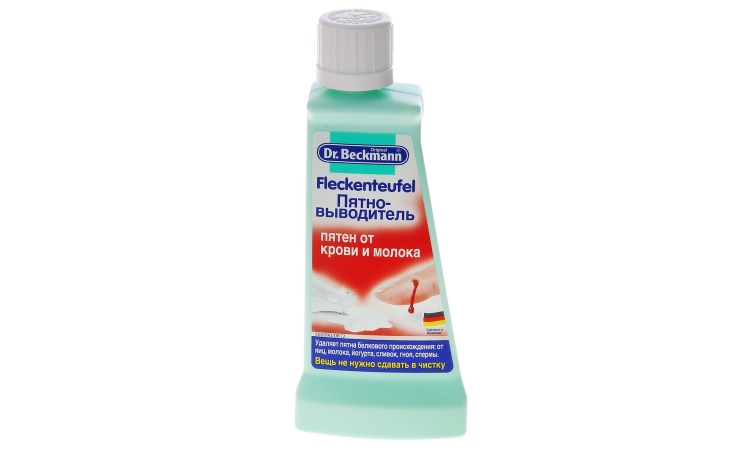
Spray Amway SA8
This spray is intended for pre-treatment of dirt before washing. The volume of the bottle is 0.4 l. Price - from 600 rubles.
Application:
- Spray onto the stain from a distance of 0.15 m.
- Wash normally.
Disadvantages:
- not always effective for old stains;
- high price.
Vanish Gold Oxi Action
The liquid stain remover is used in various volumes. The minimum is 0.1 ml. Price -160 rubles for 0.45 liters.
Stain treatment:
- Apply the product undiluted to the stained area.
- Rub a little.
- Measure out a portion (1 measuring cap) and add to the washing powder.
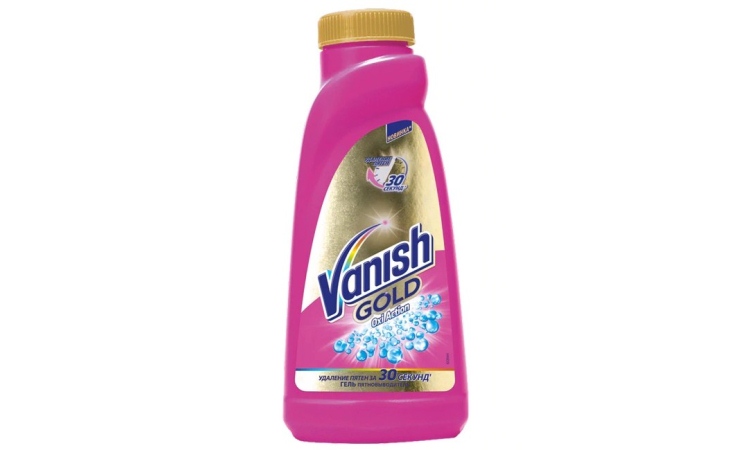
Features of removing dirt from various fabrics
Not all fabrics respond the same to stain removal recipes blood:
- thin and delicate materials should not be exposed to acids and alcohols;
- dense materials (for example, jeans) are difficult to clean from stubborn stains due to the peculiarity of the weaving of the fibers;
- white dense natural materials make it possible to actively engage in stain removal, alternating recipes.
Cotton and linen
Most cotton and linen textiles respond well to stain removal. If the material is dense and white, then you can not be afraid to use either vinegar, or ammonia, or professional stain removers with it.
Jeans
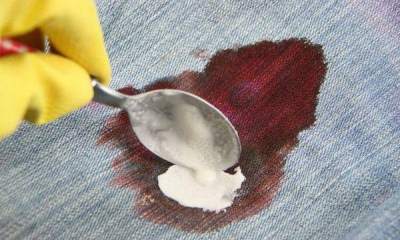 You can try to clean the denim material with a diluted dishwashing liquid... For convenience, it is best to use a toothbrush to rub the stain.
You can try to clean the denim material with a diluted dishwashing liquid... For convenience, it is best to use a toothbrush to rub the stain.
In doing so, it is more convenient to reach the fibers of the material. After processing, the jeans will need to be rinsed.
If the method did not help much, you can use a recipe based on starch or soda... Do not rub the stain intensively - the fabric may become discolored. The same problem can appear with exposure to vinegar or alcohol, especially for a long time.
White jeans are not subject to restrictions on the use of peroxide and vinegar - they can be used.
For more information on fighting bleeding on denim, read here.
Delicate materials
Delicate, even white, materials need careful handling... If the blood is not immediately washed off, it will be difficult to remove the stain, as most recipes will not work. It is possible to use only non-aggressive drugs, such as starch.
Prohibitions and restrictions
There are many ways to remove stains, which allows you to choose the most suitable one. It should be borne in mind that a deviation from the time-tested methods may not only not help, but also have the opposite effect.
Prohibitions include the following points:
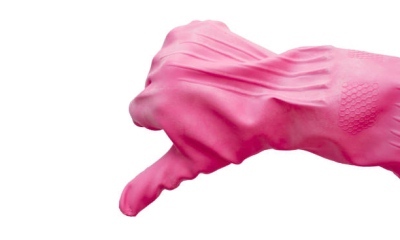 Do not use hot water to remove stains. This is due to a protein that is part of the blood, which has the property of curdling under the influence of high temperatures. In this case, the blood is fixed, not excreted.
Do not use hot water to remove stains. This is due to a protein that is part of the blood, which has the property of curdling under the influence of high temperatures. In this case, the blood is fixed, not excreted.- Avoid rubbing a fresh stain to avoid smudging it further. Better to just get wet.
- If there is no time for soaking and washing, you can apply the stain remover to the stained place, and after 10-15 minutes send the thing to wash in the machine. In this case, it is necessary to check that the water temperature is below + 30 ° C.
- If the fabric is delicate, then the use of vinegar and ammonia without a preliminary test on an inconspicuous area should not be carried out.
- Do not use solvents such as acetone or white alcohol.
Recommendations
Simple methods will help to remove the trace of blood from clothes. In addition to using recipes, you should follow these tips:
 Remove traces of blood with rubber gloves to protect your hands from exposure to chemicals.
Remove traces of blood with rubber gloves to protect your hands from exposure to chemicals.- If time was lost, the stain dried up, and then it was also incorrectly processed, the blood protein coagulates. Removing such contamination will be extremely difficult.
As a last resort, if all resources are depleted, use an intensive machine wash. However, the result is not guaranteed.
- Even for white fabrics, you should not be too zealous with stain removers, as they not only have discoloration properties, but also thin the material itself.
- Preparations with chlorine worsen the condition of the tissue and have an insidious quality - after removing the stain, its outlines are visible.
- Industrial stain removers have different instructions, so be sure to read them.
Related Videos
How to remove blood stains on clothes, video tips:
Conclusion
With a quick reaction, it is not difficult to cope with a blood stain on clothes. It will be much more difficult to remove old traces. But if you approach the issue with all responsibility, the problem is completely solvable even at home.

